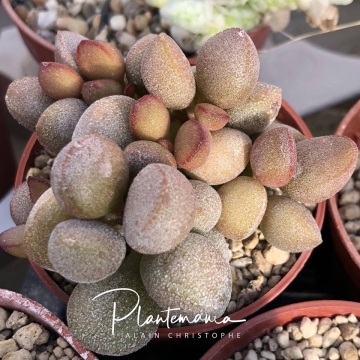
Adromischus marianae cv. Little Spheroid Photo by: Valentino Vallicelli
Origin and Habitat: This plant is native to the lower slopes of Namaqualand coastal mountains (15 km on the Nutabuoi, North of Porth Nolloth road,) Northern Cape, South Africa.
Synonyms:
See all synonyms of Adromischus marianae
Description: 'Little spheroid' is one of the innumerable morphological and geographical variant of the very variable Adromischus marianaeSN|15181]]SN|15181]]. It is a naturally occurring form distinguished by superb and very peculiar round leaves.
Habit: It is a much-branched small perennial leaf succulent, with thick stems, occasionally continued in fat fibrous roots.
Stem: Short, thick ascending often constricted at the base.
Leaves: 2-3 cm long, arranged in a spiral on the main stem, sub-spherical to elliptic, slightly concave above, faintly verrucose or almost smooth, grey-green to greyish brown with a thick bloom. Tip truncate. Base wedge-shaped. Margin at least in places horny.
Inflorescence: Spike-like thyrse with 1-flowered cyme 10-25 cm high, grey-green.
Flowers: Buds terete, slightly grooved. Flowers 1-1,2 cm long pale pink, with 5 petals basally fused to form a greyish-white cylindrical tube gradually tapered towards tip, erect at first, later spreading. Corolla-lobes 2-3 mm long, acute, spreading or recurved, pale pink with purple margins, rough and with club-shaped hairs mainly in throat. Anthers not protruding from corolla tube. 'Little spheroid' produces only a few flower-buds per inflorescence and is the lesser flowered of the 'marianae'.
Seeds: Very small.
Subspecies, varieties, forms and cultivars of plants belonging to the Adromischus marianae group
- Adromischus geyeri Hutchison: has terete, chalky, mottled reddish-brown, grey-green leaves with a rounded tip. The horny margin is often not visible at the tip. Distribution: South Namibia. Diamond Area No.1.
 Adromischus marianae (Marloth) A.Berger: (var. marianiae) has grey to reddish darker markings along the leaves. It has the longest margin along the top edge of each leaf of any other variety. Distribution: Cederberg around Clanwilliam.
Adromischus marianae (Marloth) A.Berger: (var. marianiae) has grey to reddish darker markings along the leaves. It has the longest margin along the top edge of each leaf of any other variety. Distribution: Cederberg around Clanwilliam. Adromischus marianae f. alveolatus (Hutchison) Pilbeam: similar to f. herrei but with leaves which are shorter less acute, generally more robust, and with a very rough surface. Distribution: north of Concordia.
Adromischus marianae f. alveolatus (Hutchison) Pilbeam: similar to f. herrei but with leaves which are shorter less acute, generally more robust, and with a very rough surface. Distribution: north of Concordia.- Adromischus marianae var. antidorcatum (Poelln.) Pilbeam: has a a rough leaf surface similar to A. marianiae "immaculatus". Includes forms with short leaves. it is very variable. Distribution: Namaqualand, West. & South Bushmanland.
 Adromischus marianae var. hallii (Hutchison) Toelken: has the broadest, thickest leaves within the A. marianiae complex. Leaves are chalky, grey-green but red spotted forms have been found. Distribution: South Namibia, North & West Bushmanland.
Adromischus marianae var. hallii (Hutchison) Toelken: has the broadest, thickest leaves within the A. marianiae complex. Leaves are chalky, grey-green but red spotted forms have been found. Distribution: South Namibia, North & West Bushmanland. Adromischus marianae f. herrei (W.F.Barker) Pilbeam: has the roughest leaves and can resemble dried raisins! It is a small plant, characterised by petiolate leaves, thin stems and thin inflorescences. Distribution: Namaqualand coastal mountains.
Adromischus marianae f. herrei (W.F.Barker) Pilbeam: has the roughest leaves and can resemble dried raisins! It is a small plant, characterised by petiolate leaves, thin stems and thin inflorescences. Distribution: Namaqualand coastal mountains. Adromischus marianae var. immaculatus Uitewaal: has cylindrical leaves, but with great variation in marking and texture. It usually has slighly rough leaves. Distribution: South Namaqualand, Knersvlakte.
Adromischus marianae var. immaculatus Uitewaal: has cylindrical leaves, but with great variation in marking and texture. It usually has slighly rough leaves. Distribution: South Namaqualand, Knersvlakte. Adromischus marianae var. kubusensis (Uitewaal) Toelken: Very variable in leaf shape: the plain, grey-green leaves vary from long-cylindrical to short-fat. Distribution: Richtersveld mountains.
Adromischus marianae var. kubusensis (Uitewaal) Toelken: Very variable in leaf shape: the plain, grey-green leaves vary from long-cylindrical to short-fat. Distribution: Richtersveld mountains. Adromischus marianae cv. Little Spheroid: has superb and very peculiar round leaves. Distribution: Namaqualand, Northern Cape, South Africa.
Adromischus marianae cv. Little Spheroid: has superb and very peculiar round leaves. Distribution: Namaqualand, Northern Cape, South Africa.
 Adromischus marianae cv. Little Spheroid Photo by: © Plantemania
Adromischus marianae cv. Little Spheroid Photo by: © Plantemania Adromischus marianae cv. Little Spheroid Photo by: Valentino Vallicelli
Adromischus marianae cv. Little Spheroid Photo by: Valentino Vallicelli Adromischus marianae cv. Little Spheroid Photo by: Giuseppe Distefano
Adromischus marianae cv. Little Spheroid Photo by: Giuseppe DistefanoSend a photo of this plant.The gallery now contains thousands of pictures, however it is possible to do even more. We are, of course, seeking photos of species not yet shown in the gallery but not only that, we are also looking for better pictures than those already present.
Read More... Cultivation and Propagation: Adromischus marianaeSN|15181]]SN|15181]] is a most beautiful succulent but rarely seen in cultivation. It is not the easiest species to cultivate, and highly prone to rotting off, both at the height of winter or summer.
Growth rate: It is a relatively fast growing species.
Soil: Use mineral well-permeable substratum with very little organic matter (peat, humus).
It needs perfect drainage to flourish.
Repotting: Repotting every 2-3 years. As it is especially prone to rot under-pot in a smaller container filled with very porous compost. Use pot with good drainage. All species of this genus are happy in small pots.
Exposure: It grows best in a partially shaded position. It got sunburned if exposed to midday sun.
Hardiness: Require a minimum temperature 5°C (But hardy down to -7°C for short periods), with good drainage and dryness in winter to resist the cold.
Watering: It takes more water than cacti, but let the soil dry between soaking, in the wild, it receives rain mostly in spring and fall. Must have very dry atmosphere. Water less in winter but do not allow it to shrivel.
Pest & disease: It is vulnerable to mealybugs and rarely scale. It is prone to rotting from the tuberous base or from dried inflorescences. If the plants are not watered and “aired” correctly, fungicides won't help all that much.
Maintenance: As the plant matures, the centre becomes bare. When it does, restart it from side cuttings and throw away the central part. Remove flower spikes before winter.
Propagation: Usually propagate from single leaves (leaf cuttings) or stem cuttings seed propagation is rarely used. Leaves easily root and produce new plants. Twist off a leaf and permit it to dry out a couple of days, lay it on the soil and insert the stem end partially into the soil. The original leaf should not be removed until it has dried up. Try to keep the leaf somewhat upright so that the roots are able to grow downward. If grown in a container, bottom watering by immersing the container is recommended.













